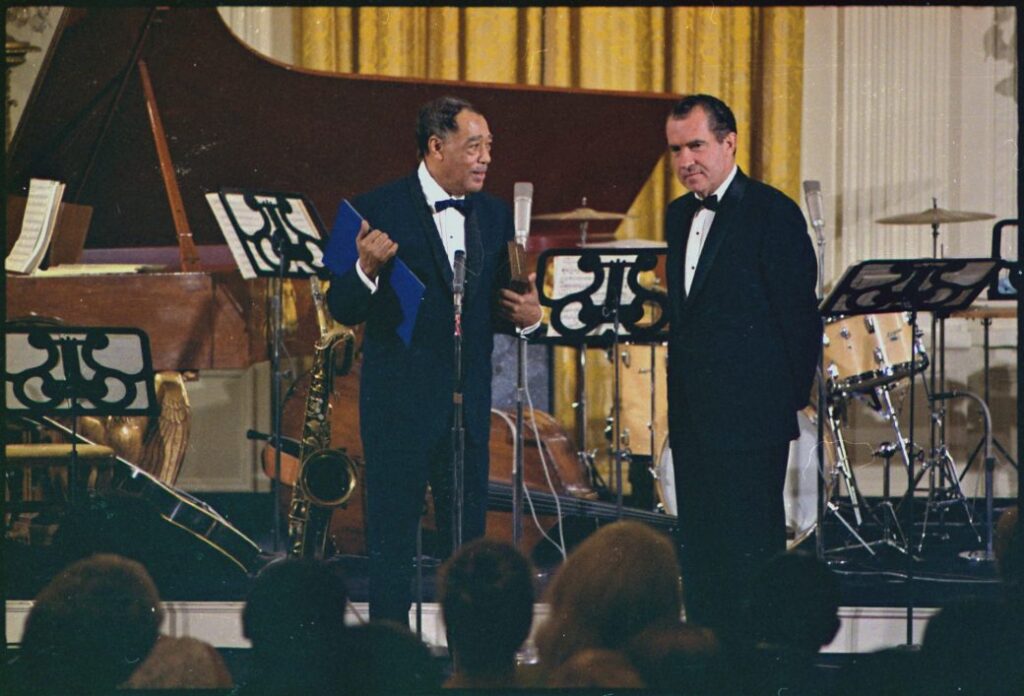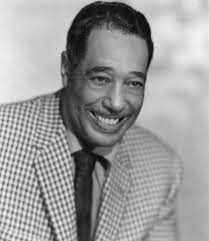Some Carp, But 40 Years After His Death, Duke’s Legacy Endures
Duke Ellington died forty years ago on May 24, 1974. He was 75; I was 20. I’d seen him six times, and suddenly felt like I’d lost my guiding light. He’d been a shepherd to countless thousands over three generations, and in the turbulent world of the sixties, a steadying presence. Blues, whether refined or gutbucket, was at the heart of Ellington’s music, which stylized African American experience and shared its uniqueness with the world. Ralph Ellison, his literary counterpart, observed in a 1969 essay, Homage to Duke Ellington, that his music provided people with a “sense of personal elegance and style…and of possibility,” while its universal appeal underscored “the white American’s inescapable Negro-ness.”
I was struck recently by a matter of Ellington’s own race consciousness while reading an article that he penned in 1939 at the request of the Pittsburgh Courier, a historically black newspaper. He was nearing the end of a triumphant tour of Europe when he sent a dispatch that read, in part, “Over there people seem to have a great appreciation for good American Negro jazz, and with that appreciation they have a great love and respect for colored musicians.” Of his reception in Sweden, he wrote, “For the first time in a long time my heart was filled with rapture and tears dimmed my eyes as these people took me, a stranger of a strange race, to their music-loving hearts.” Ellington was 40 at the time, but notwithstanding the renown he’d achieved both here and abroad, the double-consciousness that W.E.B. DuBois wrote about in his 1903 classic The Souls of Black Folk remained a prominent feature of Ellington’s thought and informed what he chose to share with blacks back home.
For me, that mournful Memorial Day weekend was partially redeemed by a stack of Ellington LP’s and the company of friends who shared my passion for Ellingtonia; by the pride I felt in seeing him hailed as “A Master of Music” in the page one obituary written by John S. Wilson for The New York Times; and by Channel 2/Boston, which broadcast On the Road With Duke Ellington that weekend and repeated it the following Saturday afternoon. But it was stained by a racist comment made to me about Ellington when I returned to work the following Tuesday. I’d grown up in a neighborhood that harbored virulent racists and often ran a late-night gauntlet of taunts and threats by some of the more outspoken of their number. Ellington disproved such bigotry, most of which I’ve forgotten, but the insult against him on the morning after his funeral was especially cruel and I’ve never forgotten it.
On the Road is the documentary that depicts Ellington as an imbiber of hot water and a connoisseur of grapefruit, steak, and ice cream. Its footage of Ellington riding shotgun with Harry Carney at the wheel of a Chrysler Imperial brings to mind Geoff Dyer’s elegiac writings on jazz. His book, But Beautiful, opens with Carney and Duke talking about the road ahead and the fried chicken they’ll eat somewhere en route to the next gig. Here’s the doc courtesy of YouTube.
And here’s a beautifully filmed performance of “Diminuendo in Blue” and “Crescendo in Blue,” linked by Paul Gonsalves’s tenor saxophone solo, one so ritualized that Duke had taken to calling it, “The Wailing Interval.” The orchestra sounds brilliant, Cat Anderson as flamboyant as ever capping the performance with high C’s.
Ellington was the most charismatic figure I’d ever been in the presence of when I first heard him in concert. The year was 1966, and it was Duke Ellington Day in the City of Worcester. To mark the occasion, Duke received the keys to the city and an honorary degree from Assumption College, then played a concert at the Memorial Auditorium where I marveled at the sound of his orchestra, and at the sight of his wardrobe on wheels. But the first time I recall hearing “Diminuendo and Crescendo in Blue” played in person was in Webster, Massachusetts, where the Ellington Orchestra stopped on its ceaseless round of one-nighters to play a benefit for the local hospital guild. The concert took place on a Sunday afternoon in 1971. My friend Nic and I were the only teenagers in the house, and we got there early enough to not only secure front row seats, but to be out front when the band’s bus arrived. When the driver opened his window and asked, “Hey fellas, where’s Duke Ellington playing?” we motioned toward the town hall behind us, then noted how hip it was that he hadn’t asked for the venue by name, but assumed anyone in town would know where the great Ellington was making a local appearance.

It was in Webster, too, where I saw a wonderful display of the bandleader’s celebrated gifts as a showman. During the first half of the concert he featured Gonsalves on virtually every number, including the show-stopping “Diminuendo and Crescendo.” Composed in 1938, these complex, interrelated works returned to the band’s book in the early fifties and became a staple after July 7, 1956, which is when Gonsalves’s 27-chorus-long interval electrified the crowd at the Newport Jazz Festival and threw it into a frenzy the likes of which jazz hadn’t ignited since the Swing Era.
Ellington’s fortunes had dipped considerably in the early fifties but were on the rebound by mid-decade, and Time was preparing a profile. With the success at Newport, it became a cover story. (Following Louis Armstrong in 1949 and Dave Brubeck in 1954, it was only the third cover that Time had devoted to a jazz artist; Thelonious Monk and Wynton Marsalis later earned the same distinction.) Ellington at Newport, the Columbia album of the concert, became the biggest seller of his career notwithstanding audio problems that made the audience more audible than the music. (A corrected edition was released in 1999 for the Ellington centennial.) This mid-career revival inspired Ellington to introduce Gonsalves, and occasionally himself, as having been born in Newport, Rhode Island, and to treat Gonsalves, who remained with him for 25 years despite his increasing unreliability due to alcoholism and drug addiction, with kid gloves.

Newport, of course, wasn’t Gonsalves’s birthplace, for like his section-mates Johnny Hodges and Harry Carney, he was a Bay Stater, born in Brockton in 1920 and raised in the Cape Verdean community of New Bedford. But when calling the roll of players in Webster, Ellington managed to bring even more of a local flavor to the tenorist’s origins. A nearby body of water commonly known as Webster Lake enjoyed a legendary reputation under its original Nipmuck name, which every school kid knew in translation as, “You fish on your side, we’ll fish on our side, and no one fishes in the middle.” Here Duke introduced Gonsalves as having been born “Just to the east of Lake Chargogagogg, Manchaugagogg, Chaubunagungamaugg.” The packed house was floored over the ease by which Ellington dropped the name.

I’m still floored by Duke, the man, the musician, the trendsetter. His was a towering achievement, one accomplished in the face of Jim Crow and the vicissitudes of show business. Consider this incident from a decade before his death: in 1964, when New Orleans officials approached George Wein about producing what would eventually become the city’s biggest tourist draw, the annual Jazz & Heritage Festival, he advised them that Ellington would be a part of anything he presented, and that he stayed only in the finest downtown hotels. New Orleans said no thanks. Six years later, the city had second thoughts. Ellington, of course, played the opening Jazz & Heritage and commemorated the occasion with The New Orleans Suite, a tonal portrait of the city and several of its illustrious natives including Mahalia Jackson, Louis Armstrong, Wellman Braud, and Sidney Bechet, all of whom performed with Duke.
Ellington spent his life in a nation divided against itself, and that’s how Terry Teachout’s recent biography of him feels. Teachout began his attempt at leveling Ellington in a 1996 Commentary essay, “(Over)praising Duke Ellington,” where he took aim at Ellington enthusiasts Albert Murray and Stanley Crouch for failing to acknowledge “the limitations…of the real Duke Ellington.” The same view drives Duke: A Life of Duke Ellington. Teachout begins by calling Ellington, who worked constantly, derided the notion of retiring, and composed somewhere between 1500 and 2000 works, “the most chronic of procrastinators.” He charges that Duke was “never a natural melodist,” and continually refers to the set of hit songs played by the Ellington Orchestra as the “dreaded medley.” A puritanical strain infects his judgments about Ellington’s sex life and his use of terms like “whores” and “loose women” in assessing Ben Webster’s character. Overall, it’s hardly an exaggeration to say that every page is top-heavy with criticism but oddly anchored by claims for Ellington’s genius.
Ellington still awaits a biographer who can capture something of his guarded private life while assessing the music in terms less contentious and attention-seeking than Teachout’s. Harvey Cohen’s 2009 publication, Duke Ellington’s America, offers a more illuminating and detailed study of the career while displaying an informed sensitivity to the racial dynamics of Ellington’s world, but it’s received far less attention. Teachout’s was prominently reviewed in The New Yorker and The Times Book Review, where silly and spurious statements knocking Ellington’s skills as a pianist and songwriter were expressed to readers perhaps far greater in number than those who’ll read the bio itself. Just last week, The New Yorker asked if Sun Ra shouldn’t be accorded the same status as Ellington and Count Basie? This, I suppose, is inevitable, given an arts establishment that rewards the esoteric and slides inexorably toward the margins, and jazz education programs that place little emphasis on stage deportment and the common ground between performer and listener that figures like Ellington and Basie always respected.
Shortly after Duke’s death, Kenny Burrell recorded one of the first Ellington repertory albums; the guitarist called it, Ellington Is Forever. Scores of other jazz artists have followed suit, and Wynton Marsalis has rightly placed Ellington at the center of Jazz at Lincoln Center’s programming and education efforts. Of the countless tributes paid Ellington over the years, perhaps no one spoke more revealingly than Miles Davis, who was notoriously averse to flattery. “I think all musicians should get together one certain day and get down on their knees and thank Duke.”
I heartily agree. Thanks always, Edward Kennedy Ellington.